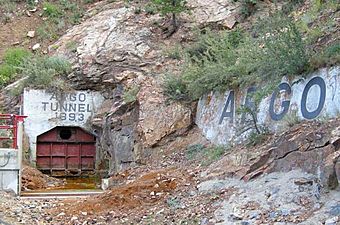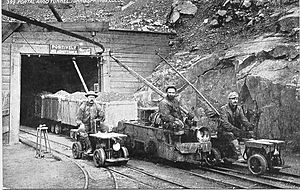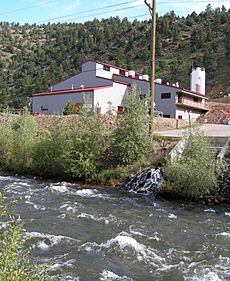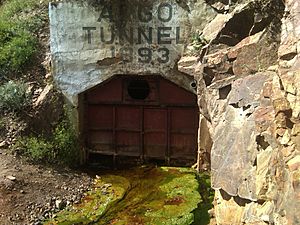Argo Tunnel facts for kids
Quick facts for kids |
|
|
Argo Tunnel
|
|

Argo Tunnel in 2009
|
|
| Lua error in Module:Location_map at line 420: attempt to index field 'wikibase' (a nil value). | |
| Location | 2517 Riverside Dr., Idaho Springs, Colorado |
|---|---|
| Area | 20 acres (8.1 ha) |
| Built | 1893 |
| Architect | Multiple |
| NRHP reference No. | 78000836 |
| Added to NRHP | January 31, 1978 |
The Argo Tunnel is a super long tunnel, about 4.16-mile (6.69 km) (that's over 4 miles!) in Idaho Springs, Colorado. It was built to help gold mines in the area. Imagine a giant drain for mines!
This tunnel had two main jobs:
- It drained water from the mines, so miners could work without flooding.
- It helped miners bring out the valuable gold ore.
It was first called the Newhouse Tunnel after the person who invested a lot of money to build it, Samuel Newhouse. The Argo Tunnel is the longest tunnel of its kind in the mining area between Idaho Springs and Central City.
Today, the mines connected to the Argo Tunnel are not active. But water still flows out of the tunnel. This water used to cause a lot of pollution in a nearby river called Clear Creek. Now, the United States Environmental Protection Agency (EPA) has a special plant that cleans the water before it goes into the river.
You can even visit the Argo Gold Mine and Mill today! As of 2017, you can go on a tour that includes seeing the front entrance of the tunnel.
Contents
Building the Argo Tunnel
The Argo Tunnel started being built in September 1893. It took a long time to finish, finally reaching its full length of 4.16 miles (6.69 km) in November 1910. The actual digging took about nine years and seven months. This tunnel was designed to connect with almost all the big gold mines between Idaho Springs and Central City.
Why Was the Tunnel Built?
The tunnel was built with a slight slope, like a gentle ramp. This was super smart because it meant water from the mines could just flow out by itself! Miners didn't have to use pumps to get rid of the water.
The slope also helped move the gold ore. Heavy carts filled with ore could roll downhill towards the tunnel entrance. Then, empty carts could be pulled back uphill more easily. Before the tunnel, miners had to lift ore straight up out of deep mine shafts. Then they had to truck it to trains or mills. The tunnel made everything much faster and easier!
The tunnel was dug in a specific direction, hoping to find new gold veins. However, there are no records that important new gold discoveries were made directly by the tunnel itself.
The Tunnel's Closure
The Argo Tunnel was used until January 1943. An accident happened when miners were working on a new section. They accidentally broke through a wall that was holding back a lot of water from a flooded mine. A huge amount of water burst through the tunnel. Sadly, four miners working at that spot lost their lives. A fifth person near the tunnel entrance barely escaped. Water kept gushing out for several hours.
Around the same time, because of World War II, the government ordered all gold mines in the U.S. to close. This was to make sure workers and resources were available for metals needed for the war. Because of the accident and the war order, the Argo Tunnel never reopened for mining.
Cleaning Up the Water
Even after it closed, the Argo Tunnel kept draining acidic water from the mines. This water had dissolved metals in it, which was a big problem for Clear Creek. In May 1980, a large rush of water from the tunnel made the creek turn orange! This happened because a part of the tunnel's roof collapsed, letting out a lot of stored water all at once.
Because of this pollution, the United States Environmental Protection Agency (EPA) added the tunnel to a special cleanup list in 1983. This list is for serious pollution sites, called Superfund sites. The EPA built a special water treatment system near the tunnel's entrance. This plant started working in 1998. It cleans about 700-US-gallon (2,600 L) of acidic mine water every minute! It removes harmful metals and makes the water safe before it flows into Clear Creek.
Later, a strong wall was built inside the tunnel, about 200 feet from the entrance. This helps control the water flow and prevents sudden gushes.
Images for kids








